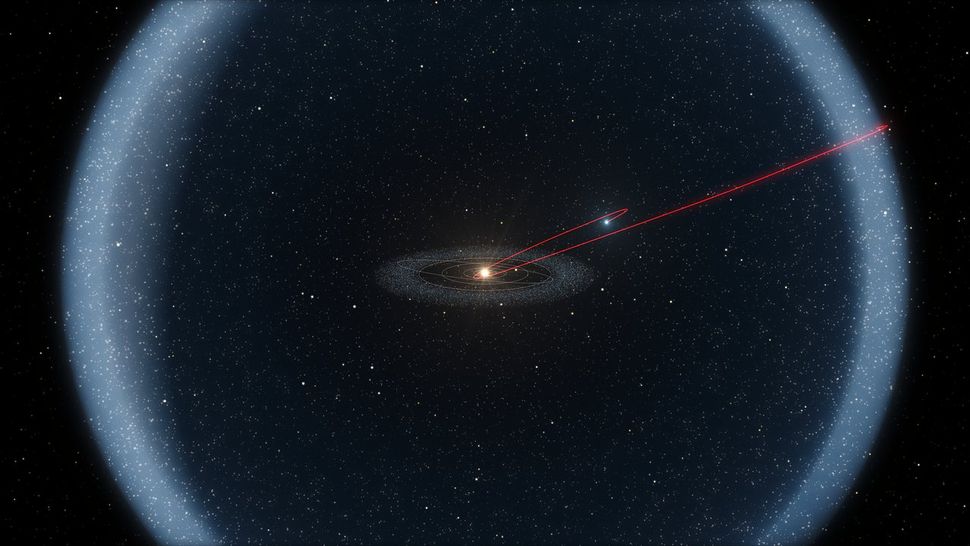A ‘rogue star’ won’t collide with our solar system
- November 7, 2023
- 0
The solar system of the distant future is protected from a collision with a dead star. Last year, researchers studied the orbit of a wandering white dwarf called
The solar system of the distant future is protected from a collision with a dead star. Last year, researchers studied the orbit of a wandering white dwarf called

The solar system of the distant future is protected from a collision with a dead star. Last year, researchers studied the orbit of a wandering white dwarf called WD 0810-353 with the Gaia space telescope and predicted that it should collide with our solar system in about 29,000 years. While this may seem like a long time in human terms, it is a relatively short time in cosmic terms. For example, the Sun will not run out of hydrogen and will turn into a red giant for another 5 billion years, destroying the Earth and the inner planets.
While the Sun’s fate is likely sealed, new research suggests our planet won’t have to worry about extinction, at least not due to the chaos caused by white dwarf WD 0810-353. In fact, the “rogue star” will not only miss the solar system; Astronomers say it may not be moving in our direction at all.
“We found that the approach velocity measured by the Gaia project is incorrect and that the predicted close collision of WD0810-353 with the Sun will not actually occur,” astronomer Stefano Bagnulo said in a statement. “In fact, WD0810–353 may not be moving towards the Sun at all. That’s one less field hazard we have to worry about!”
What did Gaia get wrong?
Gaia is a space telescope that is currently creating an extremely precise 3D map of more than a billion stars in our Milky Way galaxy. It does this by precisely measuring the positions of stars and tracking changes in those positions by rotating that “piece” of the sky and watching again to see what has changed.
In 2022, astronomers Vadym Bobilyov and Anisa Baikova analyzed a large Gaia dataset to find stars that appeared to be heading towards the Solar System. This led them to WD 0810-353, a white dwarf that is a type of dense stellar remnant left behind after the death of stars with masses similar to that of the Sun.
Our Sun will collapse into a white dwarf about a billion years after the red giant’s destructive spell, when the Sun’s swollen outer layers cool and retreat, leaving behind a smoldering core.
WD 0810-353 may offer a preview of what the Sun will look like when it comes within half a light-year of the Solar System, which is about 31,000 times the distance between Earth and the Sun.
While this may not seem like a close encounter at all, it’s close enough that WD 0810-353’s gravitational pull could disrupt the Oort Cloud, the bodies of comets, and other icy bodies at the edge of the Solar System.
The Oort Cloud is located 2,000-100,000 times the distance between the Earth and the Sun from the central star of the Solar System. As the cloud passes by transiting stars such as WD 0810–353, the star’s gravity may knock some of these weakly gravitationally bound icy bodies toward the interior of the Solar System and Earth.
So what happened to this crazy white dwarf sighting? What made astronomers think it was moving in our direction, and how do we know it probably wasn’t?

magnetic entanglement
Observations of WD 0810-353 revealed that Gia had lost something important and unusual about this white dwarf. It has an extremely large magnetic field.
“It is unusual that this old white dwarf also has a huge magnetic field,” explains Eva Villaver, an astronomer at the Center for Astrobiology in Spain and co-author of the study. “In astronomy, magnetic fields are critical to understanding many physical aspects of a star, and ignoring them can lead to misinterpretation of physical events.”
By calculating the white dwarf’s radial velocity (the object’s speed along the line of sight from the observer to the object), astronomers determined that WD 0810-353 was heading toward us. This is done by looking at the spectrum of light emitted by a star and then dividing it into the component wavelengths that make up that light.
If the star is moving towards us, this will cause the wavelength to increase and shift the light towards the red end of the electromagnetic spectrum; This phenomenon is known as redshift. However, if the star is moved away, the wavelength of the light it emits becomes longer and shifts towards the blue end, which is defined as “blue shift”.
The point is that magnetic fields can also affect the light spectrum of a star, dead or not, by splitting the spectral lines and shifting the lines towards other wavelengths. Source
Source: Port Altele
As an experienced journalist and author, Mary has been reporting on the latest news and trends for over 5 years. With a passion for uncovering the stories behind the headlines, Mary has earned a reputation as a trusted voice in the world of journalism. Her writing style is insightful, engaging and thought-provoking, as she takes a deep dive into the most pressing issues of our time.